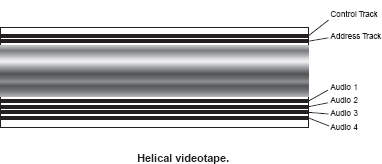Recording audio and video have different bandwidth requirements.
Analog Video Recording Standards and Formats
Audio versus Video Recording
The recording process is essentially the same for both audio and video recording, but about 200 times more information can be found in the video signal than in an audio signal.You can fit only so much information onto a given piece of tape. As a result, there's simply not enough room for all the video information using audio recording technology.
The biggest difference is that audio heads are stationary. Video uses several smaller heads mounted on a rotating disc. This allows more information to be put down in the same space.
Helical Video Recording
Helical tape machines are the standard of the broadcast industry. At least a half dozen different formats of helical videotape machines might be found in professional broadcast operations. Although none will interchange with the others, they all have some things in common. Whereas the number of heads mounted on the headwheel will vary with different formats, all helical headwheels are mounted at an angle and rotate in almost the opposite direction to the tape. The magnetic heads lay down long slanting video tracks on the tape. Each of these tracks contains one field of video information: video lines, blanking, and sync information. Therefore, if you were to slow down or stop the tape with the headwheel spinning, you would still get 60 fields of information a second, so slow motion and freeze frames are possible with helical machines. However, because of some other problems that will be discussed later, these are not broadcast-quality slow motion or freeze frames.

